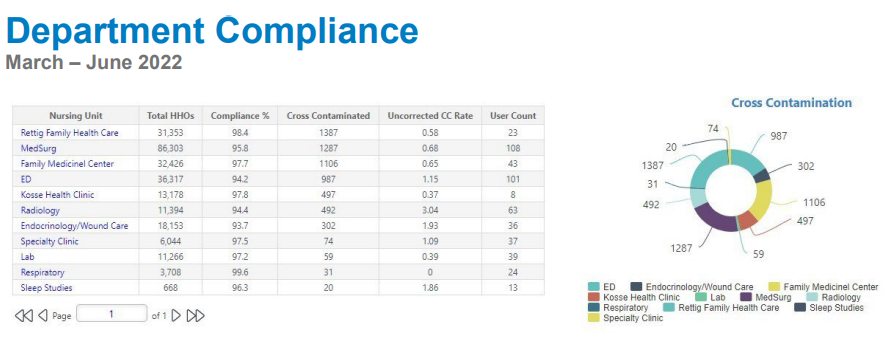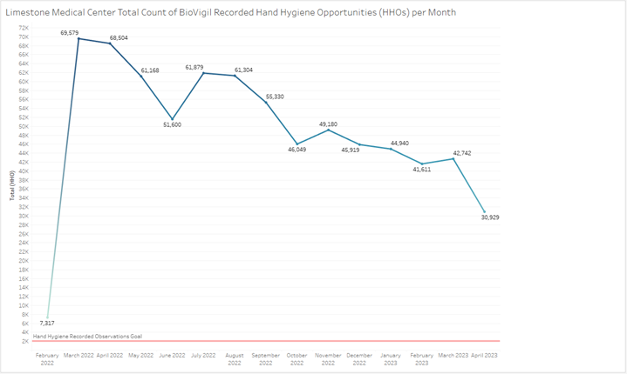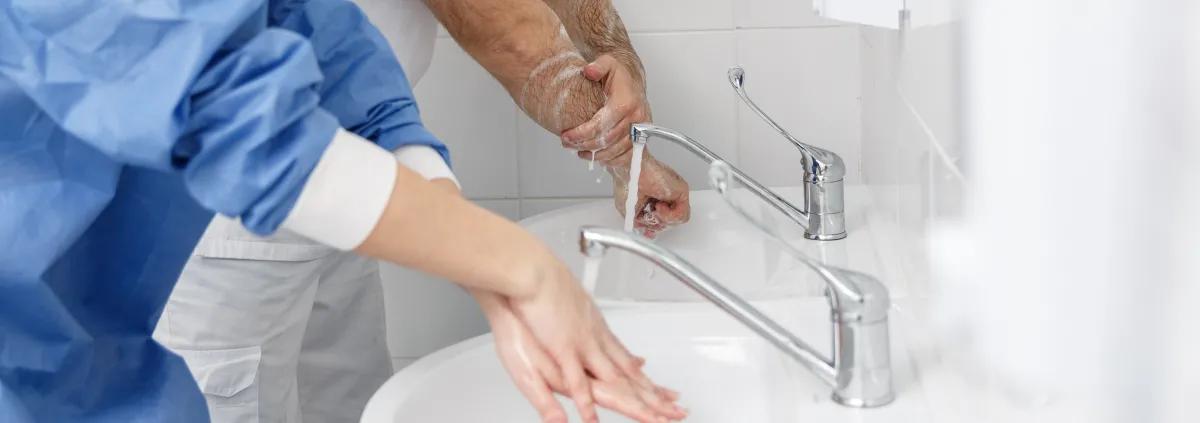Practicing hand hygiene is a simple and effective way to prevent infections. Yet, according to the Centers for Disease Control and Prevention (CDC), health care providers on average clean their hands less than half of the times they should. Additionally, on any given day, about one in 31 hospital patients has at least one healthcare-associated infection (HAI). (1)
Limestone Medical Center, a 20-bed critical access facility in Groesbeck, Texas that employs 65 nurses, was concerned about its inability to obtain reliable data on hand hygiene compliance among health care workers throughout its system. The hospital’s original hygiene program relied on manual observations which were time-intensive and flawed, due to the potential for hand hygiene behavior changes when staff were observed and observers’ desire to record positive versus negative hand hygiene practices.
“It was clear that in order to implement improvement processes or identify breakdowns in our hand hygiene program, we needed a comprehensive way to obtain insight,” according to Corey Tunnell, RN, CIC, Limestone’s infection preventionist. TMF Health Quality Institute, the Centers for Medicare & Medicaid’s Health Quality Improvement Contractor working with Limestone Medical Center, provided coaching and technical assistance throughout the selection and implementation of a new electronic hand hygiene electronic monitoring system.
Infrared Technology Promotes Hand Hygiene
With a grant from the Small Rural Hospital Improvement Program (SHIP) COVID-19 Testing and Mitigation Program, the facility purchased and implemented an electronic monitoring system in all patient care areas – encompassing exam rooms, inpatient rooms, radiology, lab draw rooms, therapy gyms, sleep study areas, and ancillary clinics – at the beginning of March 2022. The electronic monitoring system automatically documents each health care worker’s “upon entry” and “upon exit” hand hygiene moments, part of the “five moments of hand hygiene” recommended by the CDC and World Health Organization (WHO). A total of 63,987 moments were recorded in March, with a compliance rate of 96.01 percent.
The new system employs beacons which use infrared technology to prompt health care workers to perform hand hygiene. Each team member wears a badge with a hand that illuminates red (dirty hands), yellow (reminder to wash), and green (clean hands) and is visible to patients in real time. This allows the patient to be an active participant in their health care team.
Installation and Training
Installation and on-site training for the monitoring system took one week averaging 20 minutes of training per department. Staff training included a virtual component (video and online quiz) before one-on-one on-site training by the hospital infection preventionist and the vendor’s project success manager. After installation, feedback forms and routine rounding allowed team members to discuss any concerns and reduce barriers to full integration of the system into their daily workflow.
Implementation and Early Lessons from the Data
Upon implementation, data revealed that Limestone had its lowest compliance rates during the “entry/before contacting a patient” moments. This information helped the facility target staff education efforts around this phase of hand hygiene. Additionally, staff discovered that the environmental services department experienced a significant rate of cross-contamination due to inappropriate personal protective equipment (PPE) use. Data from the new system enabled staff to investigate the situation, identify the user and barrier to compliance, and provide one-on-one education.

“The purpose of data collection is not simply to meet regulatory requirements,” says Tunnell. “It is about what you can learn from the data and the opportunities you receive to improve your health care team's performance, ultimately increasing patient safety.”
Benefits of Electronic Monitoring System
Tunnell researched several products before selecting an electronic monitoring system for Limestone. Part of the selection process included representatives of staff from each clinical department. The group participated in on-site demonstrations and were encouraged to offer feedback which increased buy-in. Tunnell ultimately chose a system because of its ease-of-use, cloud-based information storage, and inability to “cheat the system.” For example, an employee cannot falsify wearing their badge because the system identifies a target number of hand hygiene opportunities (HHO) based on job and department for each shift, so missed HHO targets or high rates of HHO exceptions are a red flag and generate a report for review and individual follow-up.
TMF Coaching Facilitates Implementation
TMF assisted Tunnell during this process by providing topic-specific data, one-on-one coaching on quality improvement best practices, and recommendations for effective presentations to stakeholders and decision-makers, specifically physician leadership and the hospital’s board of directors.
Although some of the clinical providers expressed initial hesitation, most staff welcomed the transition to an electronic monitoring system. TMF suggested an on-site demonstration with key frontline personnel or end users to be present which created early buy-in of the product. This also allowed each department to ask questions directly to the company promoter and established involvement in implementation from the first step.
Results
The initial phase of monitoring system implementation compared the hours logged by the badge to the billing hours for each employee – an important measure of workflow integration and staff compliance with the program. In the next phase, Limestone monitored user compliance within each facility department and recognized employees for meeting or exceeding compliance goals as positive reinforcement. The facility also continued to monitor cross-contamination percentages to reduce potential HAIs related to improper practices.
In the 14 months since implementation, Limestone captured a total of 739,730 hand hygiene opportunities as depicted in the graph below. This averages 49,000 observations per month; 25 times higher than the goal benchmark of 200 observations per unit per month. Cumulative compliance is 95.6 percent as of April 24, 2023. Limestone also saw improvements in cross-contamination. Since implementation, the cross-contamination correction rate is 84 percent with an average of 1,180 corrections per month following a hand hygiene reminder.

Although the graph shows a downward trend in usage since implementation, Tunnell notes that implementation began in the height of the COVID-19 pandemic when there was a higher percentage of admissions. "I feel usage was strong and clearly compliance is above the 95 percent target," Tunnell says.
Reference:
- “Hand Hygiene in Healthcare Settings,” Centers for Disease Control and Prevention, https://www.cdc.gov/handhygiene/index.html
This material was prepared by The Bizzell Group (Bizzell), the Data Validation and Administrative (DVA) contractor, under contract with the Centers for Medicare & Medicaid Services (CMS), an agency of the U.S. Department of Health and Human Services (HHS). Views expressed in this material do not necessarily reflect the official views or policy of CMS or HHS, and any reference to a specific product or entity herein does not constitute endorsement of that product or entity by CMS or HHS. 12SOW/Bizzell/DVA-1137-07/18/2023

